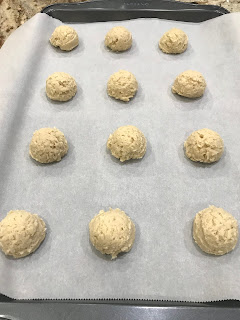 |
| Muesli in a large container that can stored in the fridge. |
Muesli can be added to yogurt, milk and as a topping to a smoothie, hot oatmeal, applesauce or stewed rhubarb. There are many ways to eat muesli. It is also convenient to take to work for breakfast or have as a snack. I store muesli in a large jar (about one and half litres or six cups) in the fridge. When ready to eat, I shake the jar a few times in order to get a good mix as some of the spices or smaller seeds might have dropped towards the bottom of the container. I use about half a cup as a serving if adding to almond or coconut milk for breakfast. I let it sit for about 2 minutes before I start to eat it. Besides the ingredients provided here, you can add other things such as cardamom, ginger, apple pie spice, dried berries and other nuts or seeds. I like adding both carob nibs and chocolate chips to the mixture.
 |
| After mixing in a large bowl. |
INGREDIENTS:
2 1/2 cups of rolled old fashioned oats (not instant)
1/2 cup raw almonds (chopped if you want)
1/2 cup raw pecans (chopped if you want)
1/4 cup flax seed
1/4 cup chia seeds
1/4 cup raw pumpkin seeds
1/4 cup raw sunflower seeds
1/4 cup carob nibs
1/4 cup chocolate chips
1/4 cup shredded or flaked coconut
1/3 cup raisins
1/2 tsp cinnamon
1/4 tsp nutmeg
DIRECTIONS:
Add all of the ingredients into a large mixing bowl. Mix well with a wooden spoon or spatula. Transfer to a large jar for storage. I use a measuring cup to transfer the muesli to the large jar so that I don't make a mess. If using within two weeks it can stay in a kitchen cupboard; otherwise store in the fridge. I keep the jar in the fridge.
Recipe adapted from heathermcclees.com











